21 Contemporary House Exterior Ideas for Modern Appeal
Imagine stepping outside your home and being greeted by a stunning, modern facade that instantly catches the eye. Contemporary house exterior ideas have gained immense popularity because they embody sleek simplicity, innovative materials, and a seamless blend of form and function that elevate curb appeal.
In this article, you’ll explore a variety of inspiring exterior design concepts that can transform your home into a modern masterpiece. From bold geometric shapes to minimalist landscaping, these ideas cater to diverse tastes and budgets, helping you create a stylish, welcoming exterior you can be proud of.
1. Sleek Monochrome Facade with Clean Lines
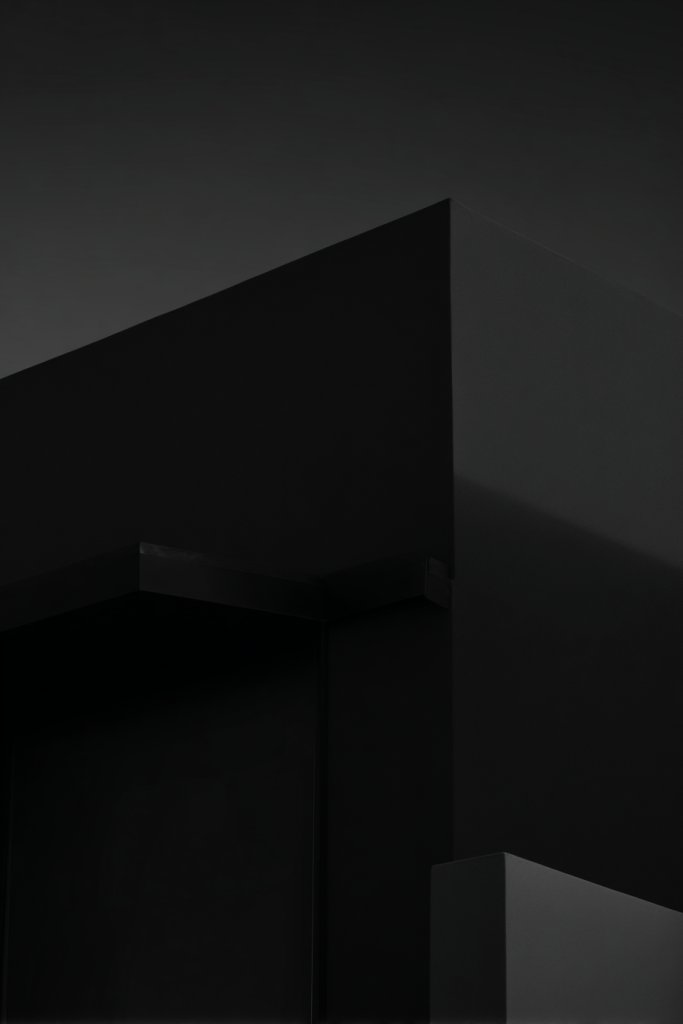
Ever dreamed of having a home that looks like it belongs in a design magazine? The idea of a sleek, monochrome exterior promises a look that’s both modern and effortlessly sophisticated. But many worry that monotony might make their house feel cold or sterile. The challenge is balancing simplicity with visual interest to create a home that invites admiration.
Imagine a façade painted in a deep charcoal black, with sharp angular lines that catch the sunlight at different angles. The surface is smooth, with subtle textures that add depth without cluttering the design. Large, seamless panels form a cohesive exterior, while hidden door handles and minimalistic accents keep the look seamless. The overall effect is a striking, clean silhouette that commands attention.
You can soften this look with warm gray shades or add contrast with a bold white trim. For a more organic feel, incorporate matte finishes or textured panels like ribbed concrete. Seasonal changes, like adding colorful outdoor furniture or textured textiles, can change the vibe without altering the core design. Smaller homes can scale this concept with vertical or horizontal paneling to emphasize proportions.
Start by choosing durable materials like fiber cement, metal panels, or high-quality paint in matte finishes. Use precise measurements to create sharp, clean lines, and consider hiring a contractor experienced in modern façade installations. Incorporate hidden drainage and ventilation to maintain the sleek look. Keep the color palette simple and consistent, avoiding unnecessary ornamentation. Finishing touches include integrated garage doors and seamless lighting that enhances the clean aesthetic.
Personalize with subtle accents like a textured concrete feature wall or a contrasting element in a different material. Use lighting to highlight the architecture at night, such as wall washers or embedded LED strips. Adding a statement door with a bold handle or unique texture can serve as an eye-catching focal point. Consider incorporating a landscape that complements the monochrome palette with minimalist plantings in sleek planters.
This style proves that less is more. With the right materials and attention to detail, you can achieve a home that’s both modern and timeless. It’s a versatile look that transitions effortlessly across different neighborhoods and personal tastes. Ready to embrace the power of simplicity and make your house a true modern masterpiece?
2. Textured Cement or Stucco Walls with Geometric Accents
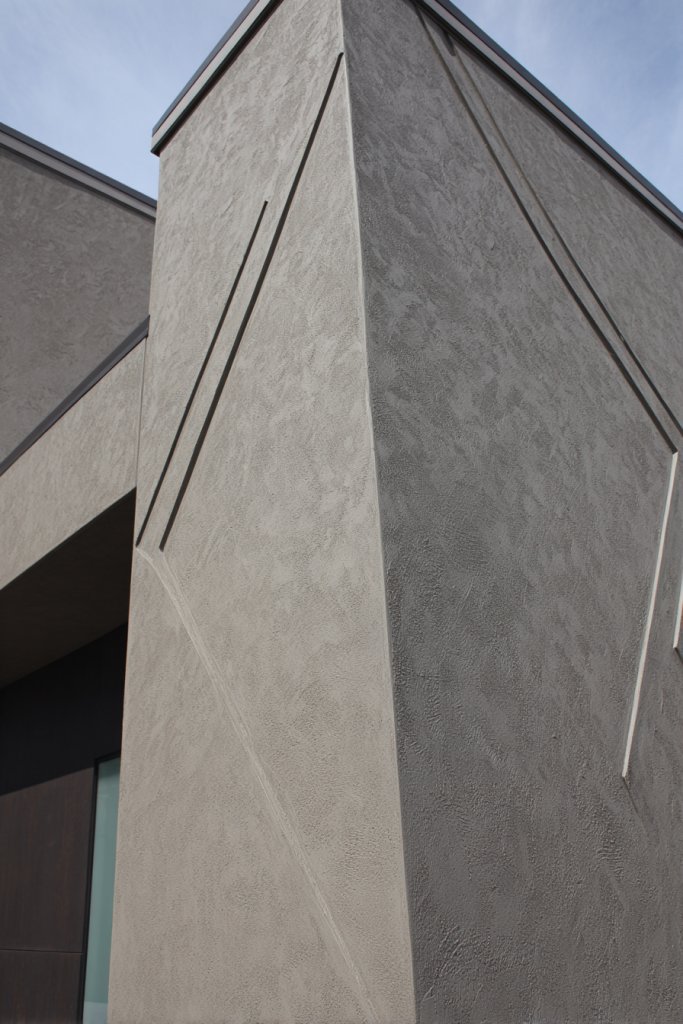
Tired of bland exteriors that blend into the background? Textured cement or stucco offers a way to add instant character and depth to any home. But the challenge is making sure these textures enhance rather than clutter the overall look. The goal is to create a façade that’s visually engaging without overwhelming the senses.
Picture a wall finished with a rough, granular stucco, interrupted by sleek, geometric panels in contrasting materials like metal or smooth concrete. The textured surface catches light and shadow, creating a dynamic, tactile feel. Sharp lines and angular shapes break up the surface, guiding the eye across the exterior. The interplay between rough and smooth textures results in an exterior that’s both bold and refined.
Mix different textures to suit your style—smooth plaster paired with rougher finishes or patterned panels. You can incorporate geometric accents like inset panels, diagonal lines, or asymmetric shapes. Seasonal accents like wooden slats or painted patterns can add a pop of color or warmth, adapting to your climate or mood. Small homes benefit from localized textured features to add interest without overwhelming the space.
Begin by selecting high-quality stucco mixes or textured cement finishes suitable for exterior use. Use stencils or molds to create geometric patterns if desired. Employ a skilled contractor to ensure clean edges and consistent textures. Incorporate contrasting materials like metal or wood accents into the design for added visual pop. Finish with weatherproof sealants that preserve the textures and prevent deterioration.
Add interest with colored textures—think warm earthy tones or cool modern palettes. Integrate lighting that emphasizes the textured surfaces, such as grazing wall lights or spotlights. Consider adding sculptural elements or architectural features that mimic geometric shapes. Personal touches like customized panels or color blocking can make the exterior uniquely yours.
This approach proves that textures and geometry can turn an ordinary façade into a work of art. It encourages exploration of materials and shapes, pushing the boundaries of traditional exterior design. With patience and creativity, you’ll craft a house that’s both innovative and inviting, standing out in the best way possible.
3. Large Floor-to-Ceiling Windows for Seamless Indoor-Outdoor Flow
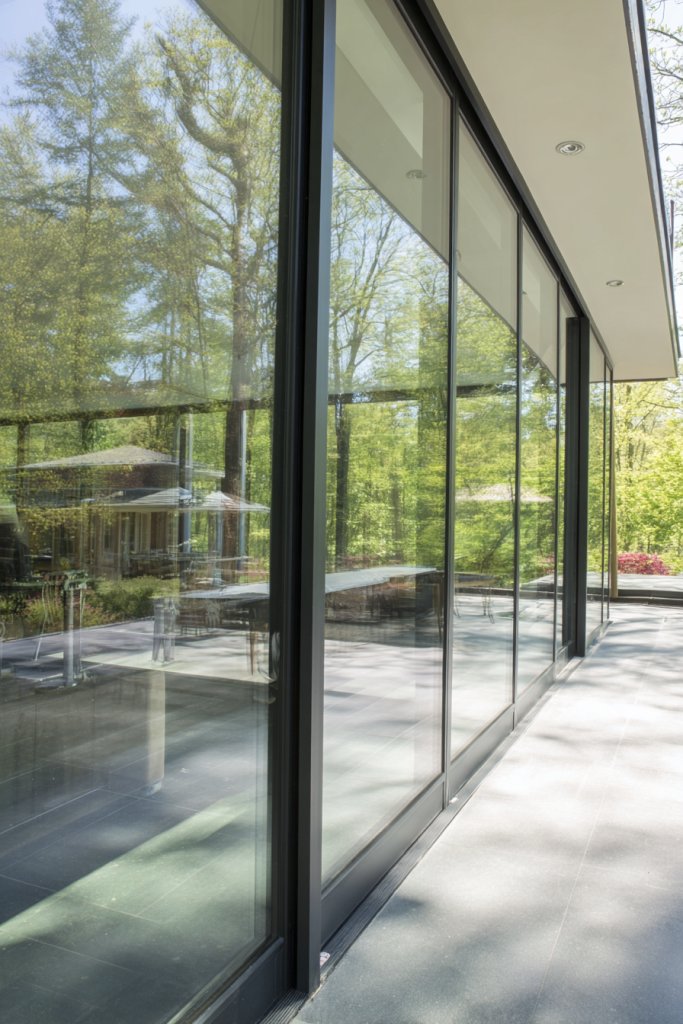
Ever wish your home felt more open and connected to nature? Large floor-to-ceiling windows are the answer, creating a seamless transition between indoor comfort and outdoor beauty. But many worry about loss of privacy or energy efficiency. The key is balancing openness with functionality to make the most of natural light without sacrificing comfort.
Imagine sliding glass doors that stretch from the floor all the way up to the ceiling, framing a lush garden or scenic view. The expansive glass reflects the sky and landscape, making the interior feel larger and more inviting. Inside, you’re greeted by floodlights of natural sunlight, illuminating every corner with warmth. The minimal frames and clean lines keep the focus on the view, turning your home into a living picture.
Opt for tinted or low-emissivity glass to reduce glare and improve energy efficiency. Use window treatments like motorized shades or sleek blinds that can be hidden when not in use. For colder climates, incorporate triple-glazed glass and insulated frames to maintain comfort. Smaller homes can incorporate these windows into a feature wall, while larger properties can create multiple open-plan zones.
Choose high-quality, durable glass with a low U-value to maximize insulation. Work with a professional to design custom window frames that blend seamlessly with your exterior aesthetic. Consider structural supports like steel beams or hidden mounting brackets to support large panes. Integrate smart glass options for privacy control or solar regulation. Proper sealing and insulation are essential to prevent drafts and energy loss.
Add external shading devices like retractable awnings or architectural screens to control sunlight and privacy. Use outdoor furniture and decor that complement the expansive windows, such as sleek seating or textured rugs. Inside, keep the decor minimal to let the views shine, or mirror the outdoor landscape with color and texture. Incorporate planters or natural elements near the windows for an organic touch.
This design elevates your home’s aesthetic and functional appeal, making it feel like a retreat. It encourages a lifestyle that embraces natural beauty and light. With the right materials and planning, your house can be both stunning and highly livable, turning everyday moments into extraordinary views.
4. Vertical Garden Wall for a Touch of Nature
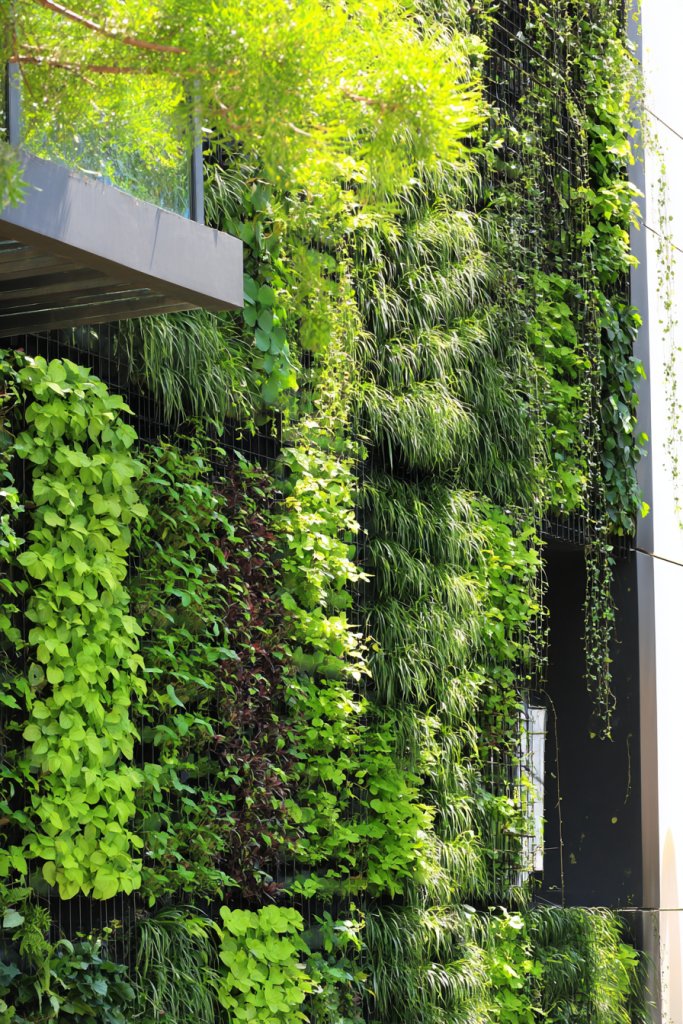
Feeling disconnected from nature while living in an urban environment? A vertical garden wall brings lush greenery directly to your exterior, adding life and freshness. But many think maintaining plants outside is complicated or messy. The trick is choosing low-maintenance, eco-friendly options that thrive without a green thumb.
Picture a sleek wall covered in a dense arrangement of succulents, mosses, or small ferns, all arranged in geometric planters or modular panels. The vibrant green contrasts beautifully with modern building materials like concrete or metal. The textured foliage creates a living sculpture that changes with the seasons, inviting your eyes to explore every nook and cranny. During the day, sunlight dances across the leaves, casting playful shadows.
Choose plant types suited to your climate and maintenance preferences—succulents for low water needs, or hardy ferns for shade. Incorporate decorative elements like textured panels or sculptural planters for added visual interest. You can also layer different shades of green or add seasonal flowering plants for a pop of color. The wall can be a focal point or a subtle background detail, depending on your style.
Start by selecting a suitable wall with good drainage and sunlight exposure. Use modular planting systems or pre-planted panels for easier installation. Ensure the wall is waterproofed and reinforced to support the weight of the plants and containers. Watering systems like drip irrigation or self-watering planters simplify maintenance. Regular pruning and feeding keep your green wall vibrant and healthy.
Add decorative elements like textured planters, embedded lighting, or sculptural garden art to personalize the space. Incorporate a variety of plant textures and heights to create depth. Seasonal accents like flowering plants or colorful foliage can refresh the look throughout the year. Personal touches like a small seating nook nearby can turn the green wall into an outdoor sanctuary.
A vertical garden wall is more than just a feature; it’s a statement of eco-conscious living. It transforms a plain exterior into a lush, inviting space that boosts curb appeal and your mood. With a little planning and care, you can enjoy a vibrant, living artwork that evolves with you and your home’s personality.
5. Flat Rooflines with Overhangs for a Modern Silhouette
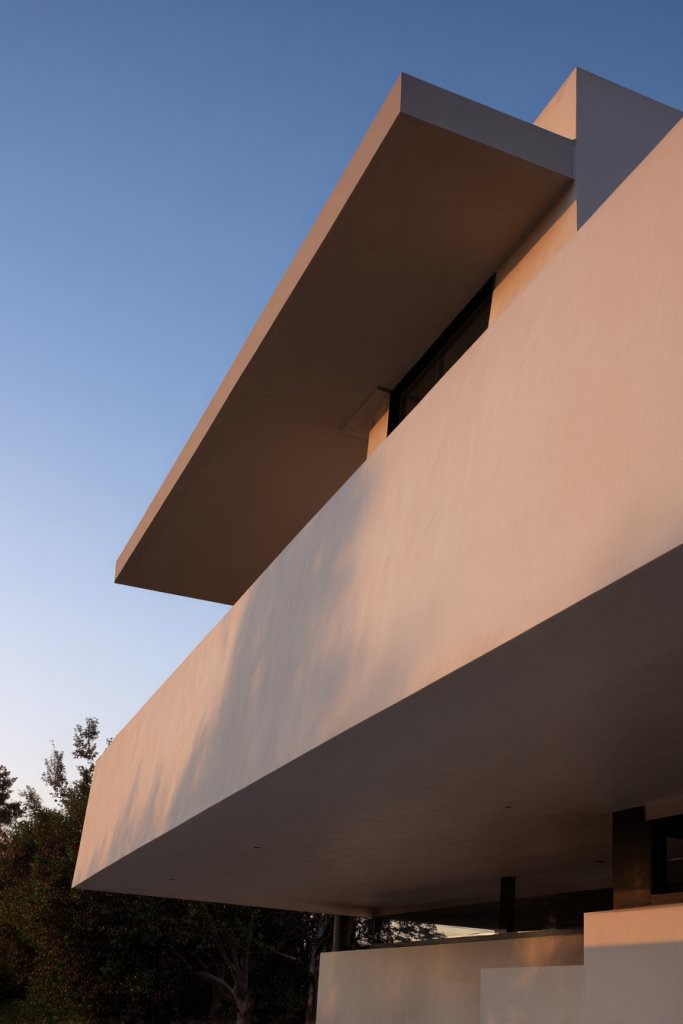
Looking for a home that stands out with a bold, modern profile? Flat rooflines with wide overhangs create a sleek silhouette that’s instantly eye-catching. But many fear that flat roofs are prone to leaks or look boring. The secret is in designing with both form and function to get a striking look that lasts.
Visualize a house with a horizontal, flat roof that extends beyond the walls in wide, dramatic overhangs. The overhangs cast deep shadows, emphasizing the clean, geometric shape. The exterior is clad in smooth panels or textured finishes, with large windows set flush to maintain the streamlined appearance. The roofline appears to float effortlessly, giving the house a futuristic feel.
Experiment with different overhang widths or asymmetrical designs for a more dynamic look. Use contrasting materials like metal, wood, or concrete to add visual interest. Seasonal elements like outdoor shading screens or retractable awnings can adapt the design for weather changes. Small homes can use a simple flat roof with subtle overhangs, while larger properties can incorporate multiple levels for a layered effect.
Choose durable, waterproof roofing materials like membrane or coated concrete. Ensure proper drainage with hidden gutters or slope designs to prevent water pooling. Consult with structural engineers to support wide overhangs without sagging. Use clean lines and hidden fasteners to maintain the modern aesthetic. Incorporate lighting beneath the overhangs for nighttime drama and safety.
Add architectural lighting like wall washers or strip LEDs to highlight the roof’s edge. Incorporate outdoor living spaces like patios or decks beneath the overhangs for functional outdoor rooms. Use contrasting textures on the façade to emphasize geometric shapes. Personalize with unique features such as rooftop gardens or solar panels integrated seamlessly into the flat roof.
Flat rooflines with overhangs redefine contemporary architecture and inspire bold design choices. They convey a sense of stability and sleekness that’s hard to match. With proper planning and materials, your home will look modern, innovative, and built to last. Ready to embrace a silhouette that’s both functional and fabulous?
6. Use of Natural Materials Like Stone and Wood Accents
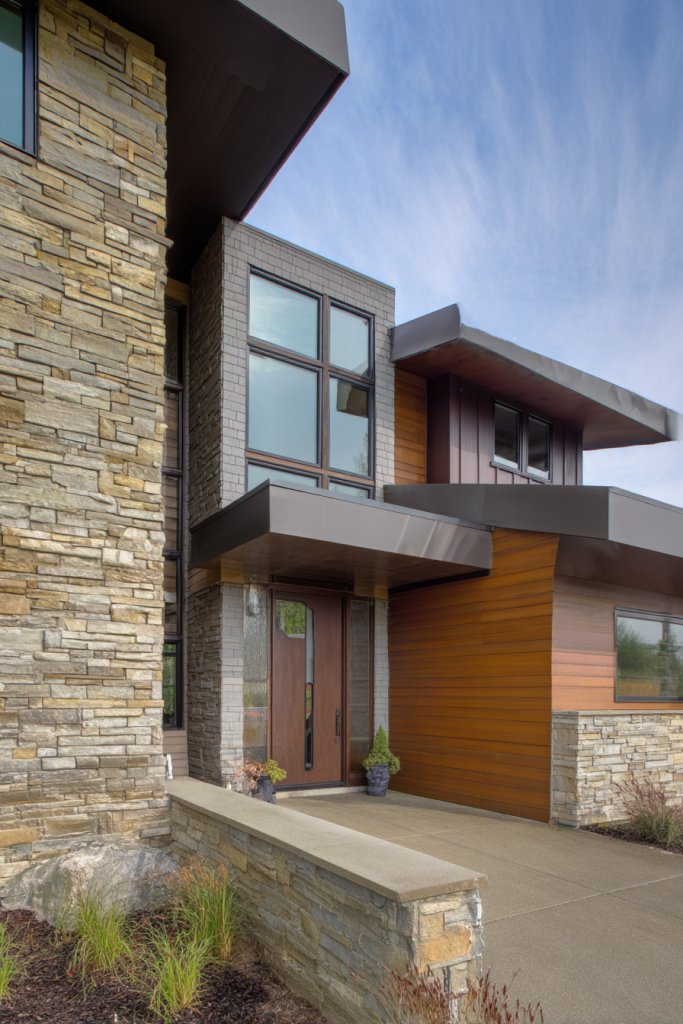
Craving a warm, inviting exterior that balances modern design with timeless appeal? Natural materials like stone and wood can soften sharp lines while adding rich texture. But many worry about maintenance or the durability of these materials outdoors. The trick is selecting the right types and finishes to ensure longevity and aesthetic harmony.
Imagine a façade where sleek concrete forms are complemented by warm, textured wooden panels and rugged stone accents. The natural grains and textures create visual depth, inviting touch and curiosity. The combination of rough stone and smooth wood creates a layered look that feels both organic and refined. Soft lighting highlights these textures, especially at dusk when they glow with warmth.
Mix different types of stone—like sleek marble or rustic limestone—with various wood finishes, from smooth stained cedar to weathered reclaimed timber. Use stone as a foundation or feature wall, and incorporate wooden cladding on upper sections or accents. Seasonal treatments like staining or sealing can refresh the look and protect against weather. Smaller homes can focus on a stone feature or a wooden entryway for a cozy feel.
Select weather-resistant stone and wood suitable for exterior use. Work with specialists to ensure proper installation, especially for stone cladding that needs precise adhesion and sealing. Use treated or composite wood for low maintenance, and finish with protective coatings for weatherproofing. Incorporate design elements like a stone pathway or timber fencing to extend the natural theme. Regular cleaning and sealing prolong the materials’ lifespan.
Personalize with contrasting finishes—dark stone with light wood or vice versa—to create visual interest. Add integrated lighting to emphasize textures, using uplights and spotlights. Incorporate natural elements like a water feature or native plantings nearby to enhance the organic feel. Small touches like engraved stone or custom woodwork add a bespoke element.
Using natural materials connects your home to the environment and elevates curb appeal. It’s a style that ages gracefully, gaining character over time. With careful selection and maintenance, your exterior will exude warmth and authenticity, making your house both stylish and welcoming. Go ahead—blend modern design with timeless natural elements for a truly stunning exterior.
7. Integrated LED Lighting for Nighttime Drama
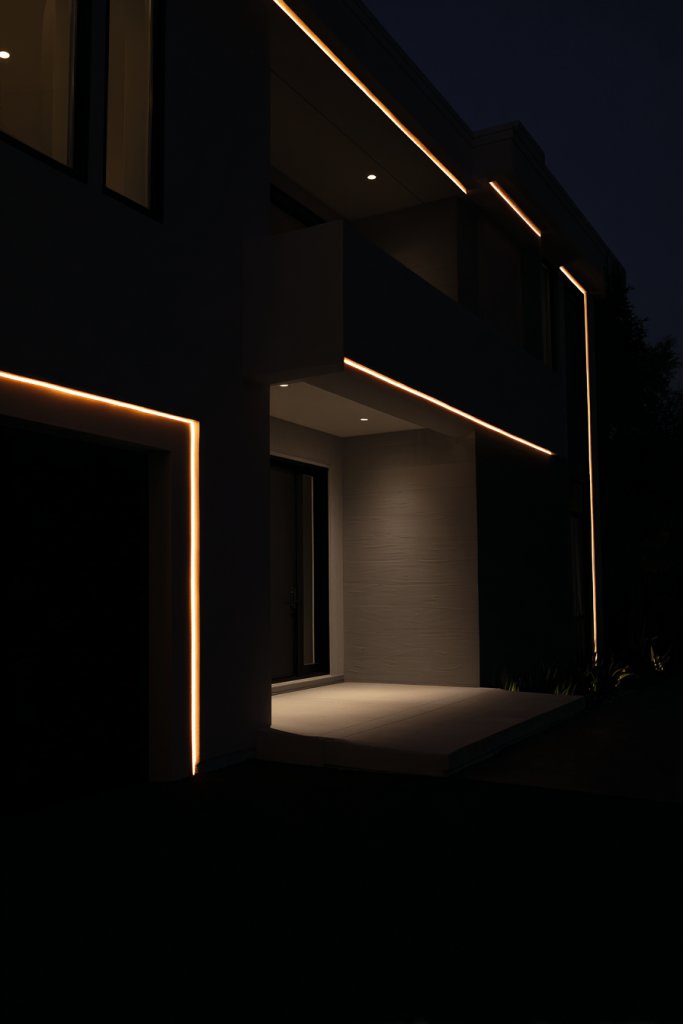
Want your home to turn heads even after sunset? Integrated LED lighting can dramatically enhance architectural features and create a welcoming ambiance. But many fear that lighting might be overly complicated or energy-consuming. The secret is choosing smart, subtle solutions that highlight your design without overwhelming it.
Visualize sleek LED strips hidden beneath overhangs, illuminating textured walls or accentuating unique angles. Wall washers cast a gentle glow on textured surfaces, revealing their details in soft light. Pathway lights guide visitors subtly, while uplights highlight vertical elements, creating depth and contrast. The overall effect transforms your house into a luminous sculpture at night.
Use adjustable or color-changing LEDs for versatile moods—warm whites for cozy evenings, cool tones for modern flair. Incorporate motion sensors or timers for energy efficiency. Exterior fixtures can be embedded into architectural features or hidden behind cladding for a seamless look. Seasonal variations like string lights or lanterns can add charm during festivities.
Start by planning the lighting layout, focusing on architectural highlights and pathways. Choose high-quality, weatherproof LED fixtures with appropriate lumens and beam angles. Install wiring discreetly within walls or soffits, ensuring safety and minimal visual clutter. Use dimmable controls or smart home systems for easy customization. Test all fixtures to ensure consistent coverage and effect.
Personalize by selecting color temperatures that match your desired mood. Add subtle accent lighting for plant-free zones or textured surfaces, emphasizing their details. Use lighting to create a sense of security and night-time charm. Incorporate timers or app-controlled systems to automate lighting changes based on your routines.
Proper lighting elevates your exterior from dull to dazzling, showcasing your home’s best features. It also boosts safety and security while creating a warm, inviting atmosphere. With smart solutions and a bit of planning, you can enjoy a house that looks stunning day and night. Light up your life—literally—and make every evening magical.
8. Minimalist Front Door with Statement Hardware
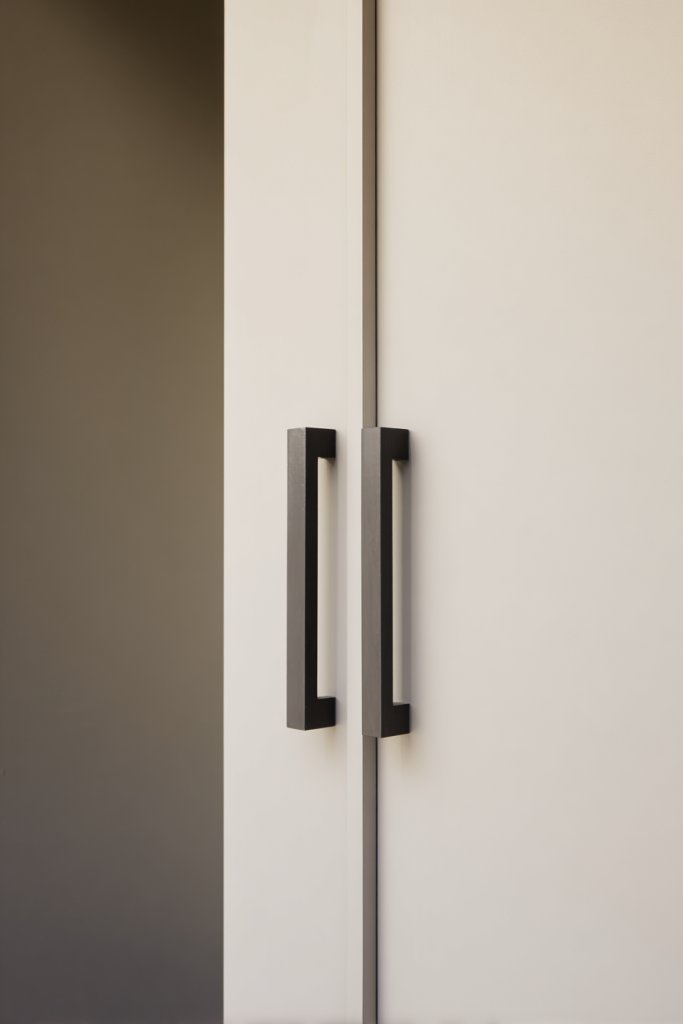
Your front door is the first thing guests see, so why settle for ordinary? A minimalist door with bold hardware can make a striking statement without clutter. But many fear that simplicity might look plain or uninviting. The trick is balancing clean design with eye-catching details to create a welcoming focal point.
Imagine a sleek door painted in matte black or bold red, with a large, geometric handle in brushed metal or matte black. The minimal design emphasizes clean lines and smooth surfaces, while statement hardware adds personality. The door is flush with the facade, with no unnecessary ornamentation, creating a modern, streamlined silhouette. Subtle lighting highlights the hardware and door surface, especially at night.
Opt for oversized handles or unique geometric shapes to add character. Use contrasting finishes—brushed metal against matte paint—for visual interest. Seasonal accents like a textured door mat or decorative trim can add a personal touch without clutter. Smaller homes might focus on a single bold handle, while larger properties can incorporate multiple hardware elements for symmetry.
Choose a high-quality, weather-resistant door with a smooth surface. Select statement hardware that complements your overall exterior style—modern, industrial, or minimalist. Use hidden fasteners or concealed hinges to keep the clean look intact. Install the hardware securely, ensuring proper alignment for smooth operation. Consider adding subtle lighting to highlight the door and hardware at night.
Customize by choosing hardware in different finishes—brushed brass, matte black, or chrome—to match your style. Add a unique doorbell or a decorative kickplate for extra flair. Incorporate seasonal wreaths or minimalist signage that won’t detract from the hardware’s statement. Keep the overall look uncluttered for maximum impact.
A minimalist front door with statement hardware embodies modern elegance and simplicity. It’s a small detail that can dramatically elevate your home’s curb appeal. With thoughtful choices, your entrance will be both functional and mesmerizing, setting the tone for your entire home’s look.
9. Contemporary Privacy Screens and Fencing
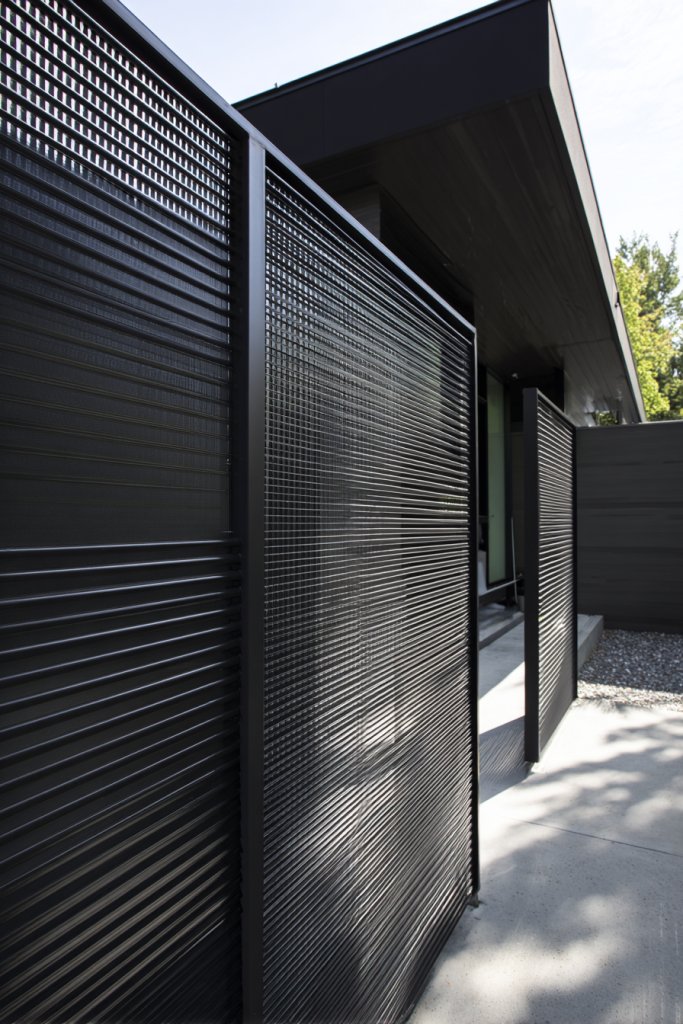
Seeking privacy without sacrificing style? Contemporary privacy screens and fencing offer a sleek solution that complements modern architecture. But many find traditional fences too bulky or outdated. The challenge is selecting materials and designs that provide seclusion while enhancing your home’s aesthetic.
Picture laser-cut metal panels with intricate geometric patterns, or tall slatted wood fences in clean lines. These screens create a rhythmic play of light and shadow, adding depth and texture to the exterior. They stand as modern sculptures, offering privacy without blocking the view or feeling oppressive. The combination of dark metal with textured wood creates a balanced, sophisticated look.
Experiment with different materials—metal, wood, frosted glass, or composite panels—to match your style. Incorporate layered screens with varying heights for visual interest and added privacy. Use lighting to accentuate patterns or textures at night. Flexible designs like movable panels or retractable screens adapt well to changing needs or seasons.
Choose weatherproof, durable materials like powder-coated metal or sealed wood. Work with specialists to design custom panels with precise cuts or patterns. Install posts securely into the ground, ensuring stability and safety. Use hidden fasteners and sealants to maintain a sleek appearance. Add lighting fixtures to highlight the screens or create ambiance during evening gatherings.
Personalize screens with custom patterns, company logos, or motifs that reflect your personality. Incorporate greenery like climbing plants or vertical gardens on some sections for softness, avoiding restricted items. Use lighting to cast artistic shadows or highlight the design features. Consider integrating storage or seating into fencing for functional appeal.
Modern privacy screens blend function with art, turning barriers into focal points. They provide peace of mind while elevating your home’s style quotient. With the right materials and design, you’ll enjoy privacy that feels intentional and stylish—no more sacrificing aesthetics for seclusion.
10. Cantilevered Elements for Architectural Drama
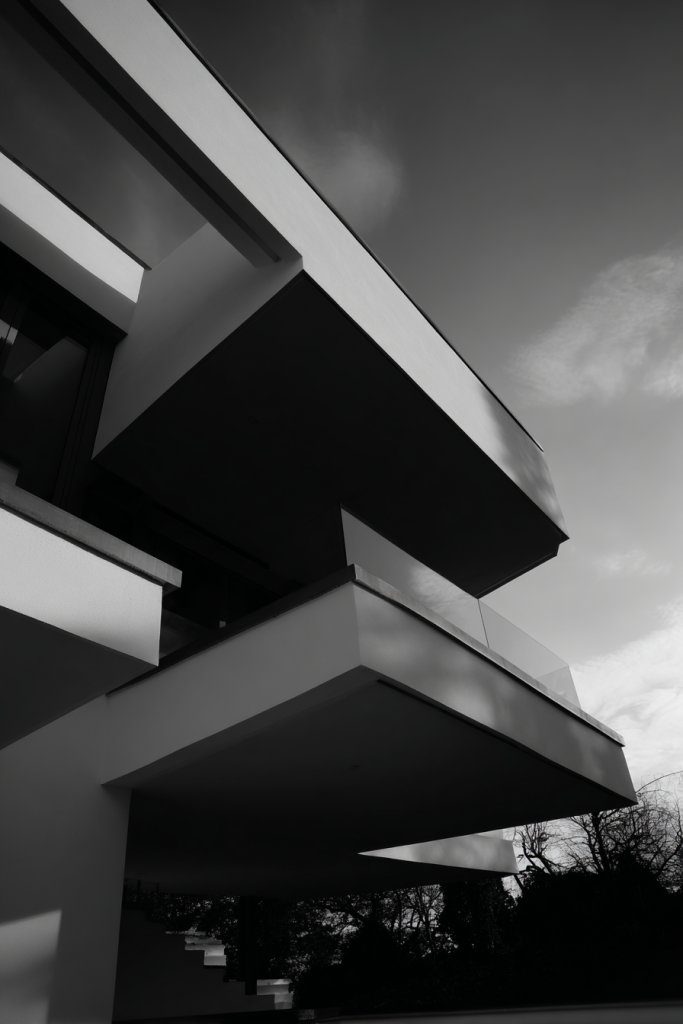
Want your house to have that wow factor with a sense of floating or defying gravity? Cantilevered elements—like overhangs or balconies—inject drama and architectural interest. But many worry about structural integrity or maintenance. The secret is smart engineering combined with bold design choices that push boundaries.
Imagine a wide, flat roof that extends beyond the walls in a dramatic overhang, creating a floating effect. A cantilevered balcony juts out without visible supports, giving your home a sculptural silhouette. The clean lines and sharp angles create a modern, futuristic vibe, especially when lit with hidden LED strips. The contrast between solid and void shapes adds visual tension and excitement.
Experiment with asymmetric overhangs or multiple cantilevered levels for a layered look. Incorporate contrasting materials—such as metal, concrete, or glass—to emphasize the architectural features. Seasonal elements like retractable shading or outdoor furniture can adapt the space for comfort. Smaller homes can focus on a single overhang, while larger estates can include multiple cantilevered sections.
Work with structural engineers to ensure support and safety. Use reinforced concrete or steel frameworks capable of handling the load. Employ hidden fasteners and clean finishes to keep the sleek look. Incorporate drainage solutions within the overhang to prevent water buildup. Ensure proper insulation and weatherproofing to protect the structural elements over time.
Add lighting beneath the overhang for night-time impact. Use textured or contrasting exterior finishes to highlight the cantilever’s edges. Incorporate outdoor living areas or planters that blend seamlessly into the design. Personal touches like custom metalwork or embedded art can elevate the architectural statement.
Cantilevered structures exemplify daring modern architecture and creativity. They showcase your willingness to embrace innovative design and craftsmanship. With proper planning, your home becomes a landmark of style and function, inspiring admiration from neighbors and guests alike.
11. Horizontal Siding with Contrasting Trim
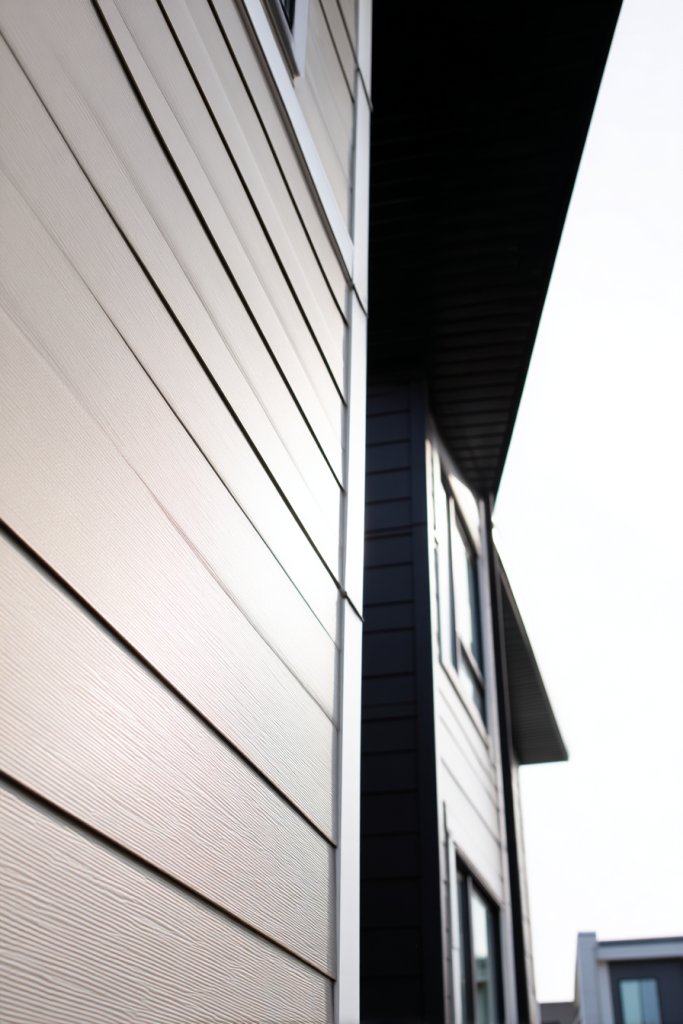
Looking to achieve a sleek, modern exterior that’s easy to maintain? Horizontal siding with contrasting trim offers a timeless yet contemporary look. But many worry about choosing the right materials and colors that won’t quickly look dated or require constant upkeep. The key is selecting durable finishes and bold accents.
Picture horizontal panels in smooth fiber cement or metal, painted in a neutral tone like slate gray or crisp white. The trim in a darker or contrasting color frames windows and edges, emphasizing clean lines. The siding’s horizontal lines draw the eye across the façade, creating a sense of width and stability. At night, strategic lighting accentuates the contrast, adding depth.
Mix textures—smooth, grooved, or ribbed siding—to add subtle variation. Play with color combinations, such as dark siding with light trim or vice versa. Seasonal updates like painting trim in vibrant hues or adding decorative shutters can refresh the look. Smaller homes benefit from narrow or wide panels, depending on scale, for a balanced appearance.
Choose high-quality siding materials suitable for your climate, ensuring they are weatherproof and low-maintenance. Use contrasting trim in durable finishes like aluminum or PVC. Plan your layout carefully to align panels and trim for a seamless look. Install with precision, avoiding gaps or misalignments that can ruin the sleek effect. Finish with appropriate sealants and paint to protect against weather.
Add decorative elements like metal accents or LED lighting along the trim line for evening impact. Incorporate different siding orientations or textures in different sections for visual interest. Personalize with colorful accents or unique window frames that match your overall design theme. Keep the look uncluttered to maintain the modern, minimalist vibe.
Horizontal siding with contrasting trim remains a classic for a reason—timeless yet adaptable. It’s a smart choice for homeowners who want a clean, structured look that ages gracefully. When done right, it creates a home that’s both stylish and easy to maintain, giving you confidence in your curb appeal.
12. Floating Steps and Pathways with Modern Materials
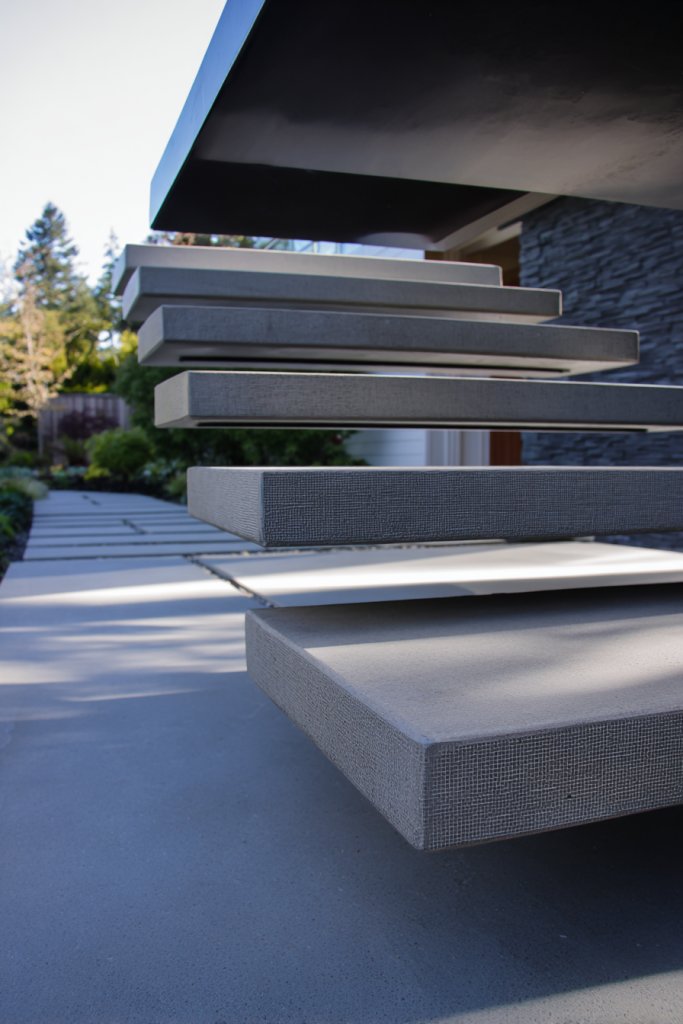
Ever wanted your entrance to feel like a modern sculpture? Floating steps and pathways create a sleek, minimalist approach that makes your home stand out. But many fear they’re complicated to install or unsafe. The secret is using the right materials and design techniques for a seamless, secure look.
Imagine steps made from large slabs of concrete or stone that appear to hover above the ground, with no visible supports. The pathway is composed of narrow, rectangular pavers or textured tiles, creating a clean grid that guides visitors. Underfoot, the materials are smooth and cool, while lighting embedded beneath or along the edges adds a floating glow at night. The overall effect is a futuristic, inviting entry.
Use different materials—such as metal, textured concrete, or large tiles—for variety. Play with shapes like rectangular, square, or curved pathways to suit your landscape. Seasonal options include heated pathways for winter or incorporating greenery in between the floating steps. Smaller homes can use narrow, linear pathways, while larger properties can create expansive courtyards.
Start by designing precise measurements and layouts, ensuring steps are stable and level. Use structural supports hidden beneath the surface or engineered to appear unsupported. Select weatherproof, slip-resistant materials for safety and longevity. Install lighting carefully to avoid tripping hazards and enhance the floating illusion. Consider professional help for complex designs to ensure durability.
Add lighting that highlights the edges or treads, creating a dramatic effect at night. Incorporate textured or patterned surfaces for visual interest. Personal touches like decorative stones or custom lighting fixtures can elevate the look. Use landscaping or artistic elements to frame the pathways and complement your overall exterior design.
Floating steps and pathways elevate your home’s entrance into a modern art piece. They combine function with high style, making every step a visual delight. With thoughtful planning and quality materials, you’ll enjoy a safe, stunning approach that impresses every guest and enhances your curb appeal.
13. Incorporation of Solar Panels with a Sleek Finish
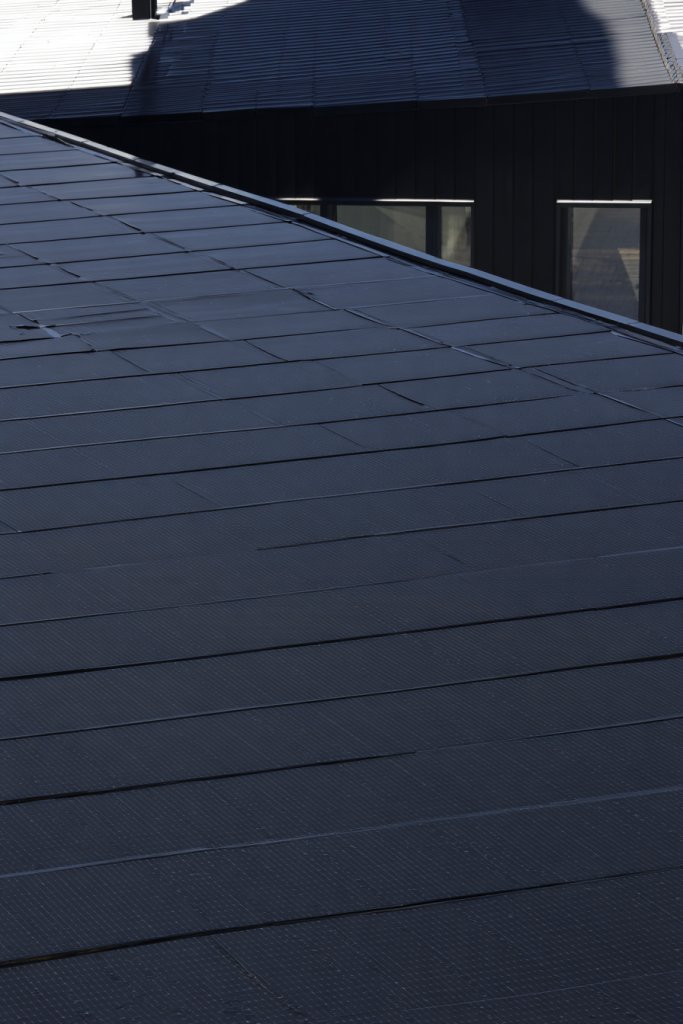
Thinking about making your home more eco-friendly without sacrificing style? Solar panels are a smart solution, especially when integrated seamlessly into your roof design. But many worry about bulky panels ruining the aesthetic. The secret is choosing sleek, low-profile options that blend into modern architecture.
Visualize dark, flush-mounted solar panels that sit nearly level with your roof surface, maintaining a clean profile. The panels are almost invisible from a distance, with a matte finish that minimizes glare. When the sun hits them, they shimmer subtly, adding a high-tech edge to your home. The overall look is minimalist, integrated, and futuristic.
Opt for black or dark gray panels for a seamless look against dark or neutral roofs. Use framing or protective coatings that match your roof material for consistency. Seasonal updates might include adding solar-powered outdoor lights or smart energy management systems. Larger roofs can incorporate solar arrays into a more geometric, grid-like pattern for artistic appeal.
Partner with a certified solar installer to ensure optimal placement and wiring. Choose panels with high efficiency and durability ratings. Incorporate flush mounting systems that keep panels close to the roof surface. Ensure your roof structure can support the added weight and install with minimal visual disruption. Connect to smart home systems for monitoring energy production.
Combine solar with other sustainable features like rainwater harvesting or green roofs. Use custom framing colors or textures that match your roof for a cohesive look. Incorporate small solar-powered accent lights or outdoor outlets that blend invisibly into the design. Personal touches like branded logos or patterns can make your solar setup unique.
Seamlessly integrated solar panels prove that sustainability and style can coexist elegantly. They add value, reduce energy costs, and showcase your commitment to eco-conscious living. With the right technology and installation, your home becomes a beacon of modern, sustainable design—bright, efficient, and stylish.
14. Bold Use of Color Blocks for Visual Interest
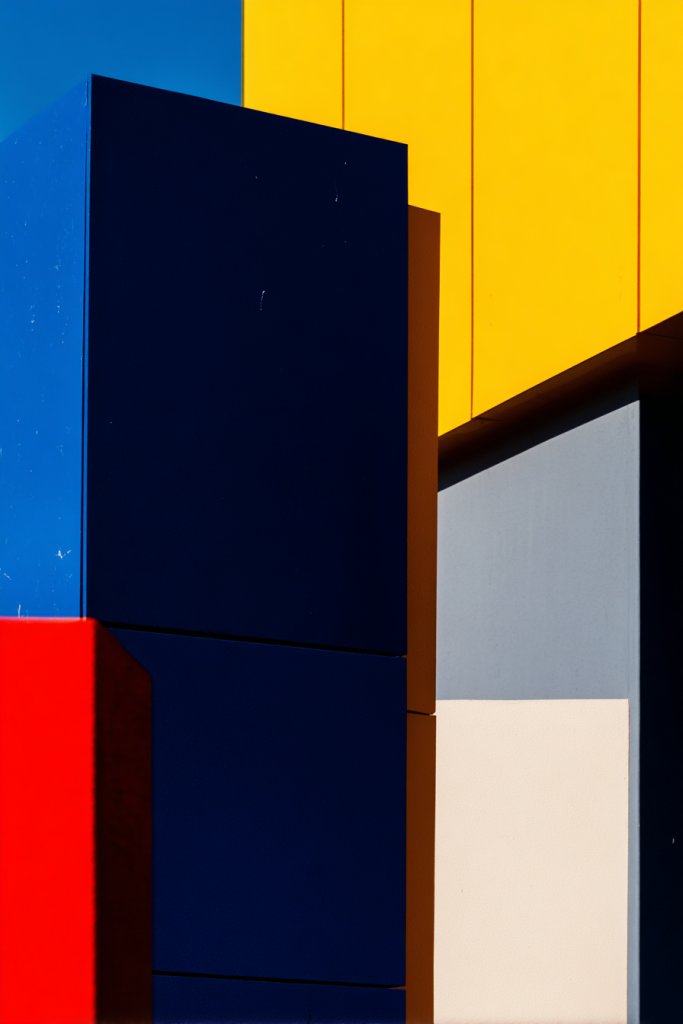
Want to add a punch of personality to a modern exterior? Bold color blocks can energize your façade and set your home apart. But many worry about overdoing it or creating a chaotic look. The key is balancing strong colors with a clean, minimalist base for a striking yet harmonious effect.
Picture a neutral-toned house—think whites, grays, or taupes—with large, rectangular sections painted in vibrant hues like deep blue, fiery red, or bright yellow. These blocks are strategically placed to emphasize architectural features or create focal points. The sharp contrast catches the eye, especially when accentuated by subtle lighting. The overall vibe is confident and playful, yet refined.
Use color blocking on specific areas like the front door, window trims, or garage doors for maximum impact. Combine matte and gloss finishes to add depth. Seasonal updates can include repainting or adding temporary decals that don’t compromise the overall design. Smaller homes benefit from limited color accents, while larger properties can experiment with multiple blocks.
Select high-quality exterior paints suitable for outdoor weathering. Use painter’s tape and level guides for sharp, precise lines. Keep the surrounding landscape simple to let the colors stand out. Consider color psychology—warm tones evoke energy, while cool shades promote calm. Regular touch-ups preserve vibrancy and prevent peeling.
Add decorative elements like contrasting trims, artistic signage, or textured finishes to complement the color blocks. Use lighting to highlight the color areas at night, enhancing their vibrancy. Personalize with unique shapes or patterns within the blocks for a custom look. Keep the overall palette balanced to avoid visual overload.
Bold color blocks demonstrate confidence and creativity, turning a simple house into a statement. They reflect a modern, playful attitude that’s full of personality. With thoughtful application, your exterior becomes a vibrant canvas that energizes your entire home’s presence and your personal style.
15. Framed Windows and Doorways with Thin Profiles
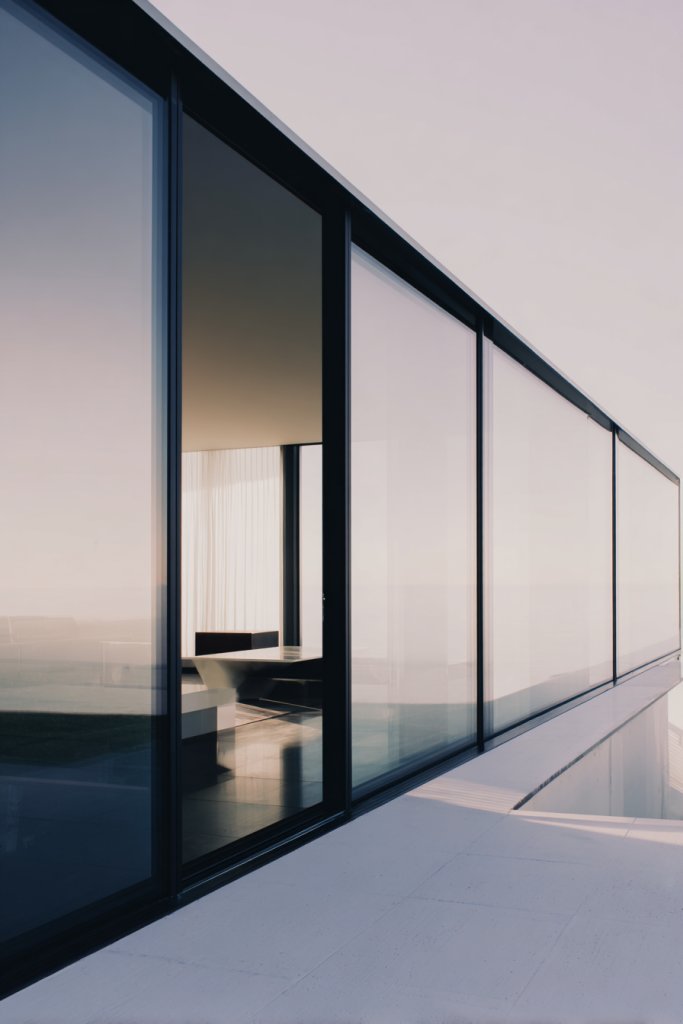
Dreaming of a sleek, unobstructed view that maximizes natural light? Thin-profile framing around windows and doors can create a modern, minimalist aesthetic. But many worry that slim frames might compromise durability or insulation. The secret is choosing high-performance materials that combine strength with style.
Visualize slender metal frames in matte black or brushed aluminum, holding expansive glass panes that seem to float within the façade. The thin profiles emphasize transparency, blurring the boundary between indoors and outdoors. This creates a light-filled, airy feel that’s both elegant and contemporary. The windows and doors become almost invisible architectural elements, highlighting views rather than obstructing them.
Opt for floor-to-ceiling windows with minimal frames for a dramatic effect. Incorporate sliding or bifold configurations for versatility. Use contrasting frame colors or finishes to add subtle visual interest. Seasonal elements like shutters or external shades can be added without cluttering the sleek lines. Smaller homes benefit from large picture windows, while larger estates can integrate multiple thin-framed openings.
Select high-quality, thermally broken aluminum or steel frames designed for minimal profiles. Work with experienced installers to ensure precise measurements and seamless integration. Use double or triple-glazed glass for insulation and soundproofing. Proper sealing and weatherproofing are essential to retain energy efficiency. Consider automated opening systems for added convenience.
Personalize with framed accents in matching or contrasting finishes, or add decorative external shading devices. Use minimal window treatments inside to preserve the sleek look. Incorporate integrated handles or hardware that blends into the slim frames. For a cohesive look, match door frames with window profiles for a unified appearance.
Thin-profile framed windows and doors redefine modern elegance and transparency. They maximize views and light, making your home feel expansive. When executed with precision and quality, this design elevates your exterior into a sophisticated statement of minimalist style.
16. Modern Garage Doors with Geometric Patterns
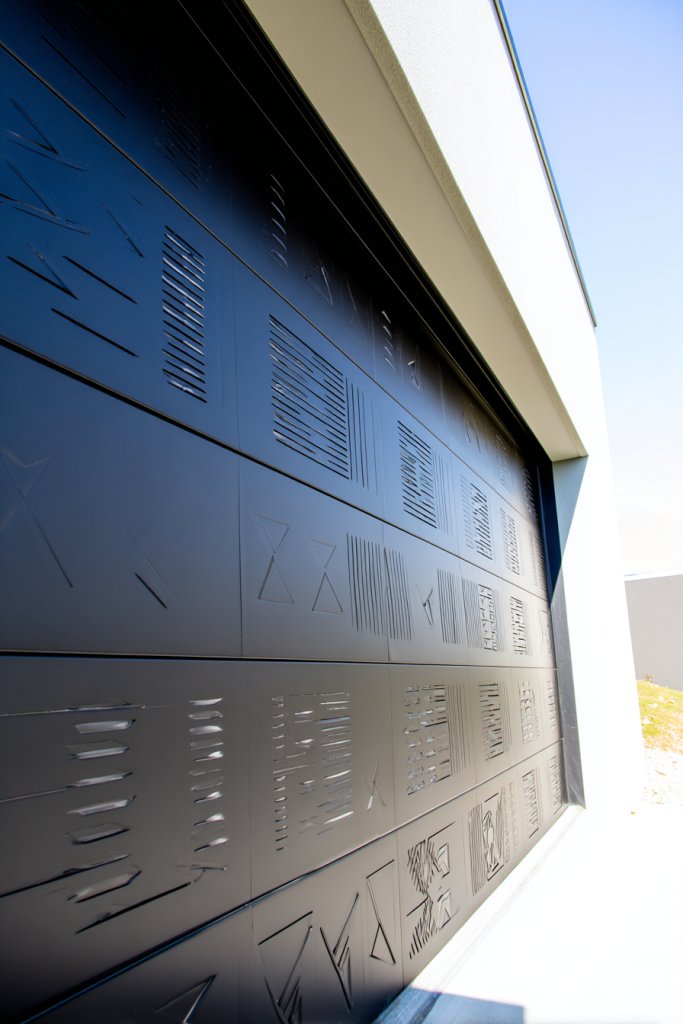
Your garage door is often the largest visual element on your façade—why not make it a piece of modern art? Geometric-patterned garage doors add a dynamic, stylish touch that elevates your entire home’s look. But many fear that intricate designs might be hard to maintain or look busy. The trick is choosing patterns that blend form and function seamlessly.
Imagine a garage door with large rectangular or hexagonal cutouts filled with frosted glass or textured panels. The repeating geometric shapes create a rhythm that draws the eye and adds depth. The door’s sleek surface is finished in matte or gloss, contrasting with textured or matte walls. At night, subtle lighting highlights the pattern, transforming a utilitarian feature into an architectural statement.
Choose from various patterns—grid, chevron, or abstract shapes—based on your style. Use contrasting colors or finishes to emphasize the pattern or keep it monochromatic for a more subdued look. Incorporate automated openers for convenience, and consider seasonal accents like external lighting or decorative elements. Smaller garages can focus on simple grid patterns, while larger ones can experiment with complex designs.
Select high-quality, durable materials like aluminum or steel with textured finishes. Work with specialists to ensure precise pattern cuts and seamless integration. Incorporate glass or textured panels that resist weathering and require minimal cleaning. Use weatherproof seals and high-quality hardware for smooth operation. Enhance with lighting to accentuate the design at night.
Personalize with custom patterns or logos if desired. Add external lighting to cast shadows and emphasize the geometric shapes. Use contrasting colors or finishes for a bold statement. Keep the design simple and clean to maintain a modern aesthetic that ages well.
Modern garage doors with geometric patterns turn a functional element into a focal feature. They showcase your style and attention to detail, making your home stand out. When done with quality materials and thoughtful design, they promise durability and a fresh, contemporary vibe that lasts.
17. Sculptural Exterior Art Installations in Metal or Concrete
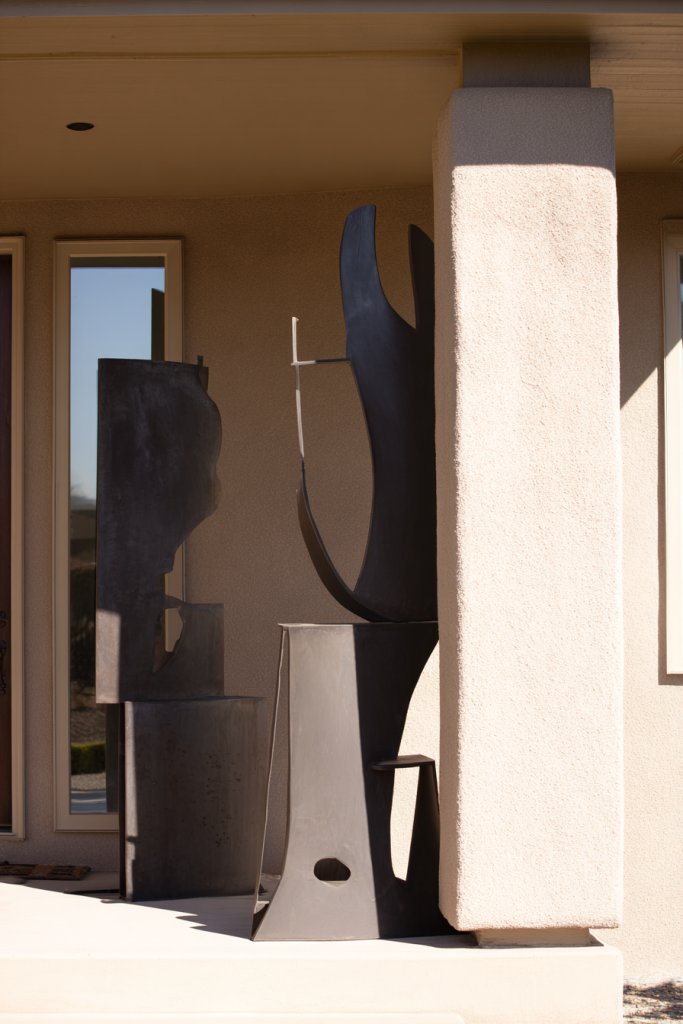
Looking to add a bold, artistic statement to your exterior? Sculptural art installations made of metal or concrete can turn your façade into a gallery-worthy display. But many fear they’ll look out of place or require excessive maintenance. The secret is choosing pieces that complement your architecture and age gracefully.
Imagine a large, abstract metal sculpture standing beside the entrance, with flowing curves or sharp angular forms. Alternatively, a textured concrete installation could serve as a backdrop or focal point, adding depth and contrast. These pieces catch light and shadow differently throughout the day, creating a dynamic visual experience. The sculptures become an extension of your home’s personality, blending art with architecture.
Select sculptures with geometric, organic, or minimalist styles to match your taste. Place them strategically near entryways, driveways, or garden walls for maximum impact. Seasonal lighting can highlight their textures and forms after dark. Incorporate sculptural elements into planters or water features to create a cohesive artistic environment.
Work with artists or fabricators to design or select pieces that suit your space. Use weather-resistant metals like corten steel or powder-coated finishes for longevity. For concrete, choose durable mixes with proper sealing. Anchor sculptures securely with hidden fasteners or embedded bases. Regular cleaning and inspections preserve their appearance.
Add lighting to emphasize sculptural forms at night, creating dramatic shadows. Personalize with custom designs or motifs that reflect your interests or heritage. Incorporate complementary materials like wood or gravel to frame the sculptures. These art pieces can also serve as conversation starters or a reflection of your personality.
Sculptural installations elevate your exterior into a piece of living art. They showcase your individuality and appreciation for design. With the right choices, these features become timeless focal points that enhance your home’s curb appeal and artistic value.
18. Layered Exterior Lighting for Depth and Dimension
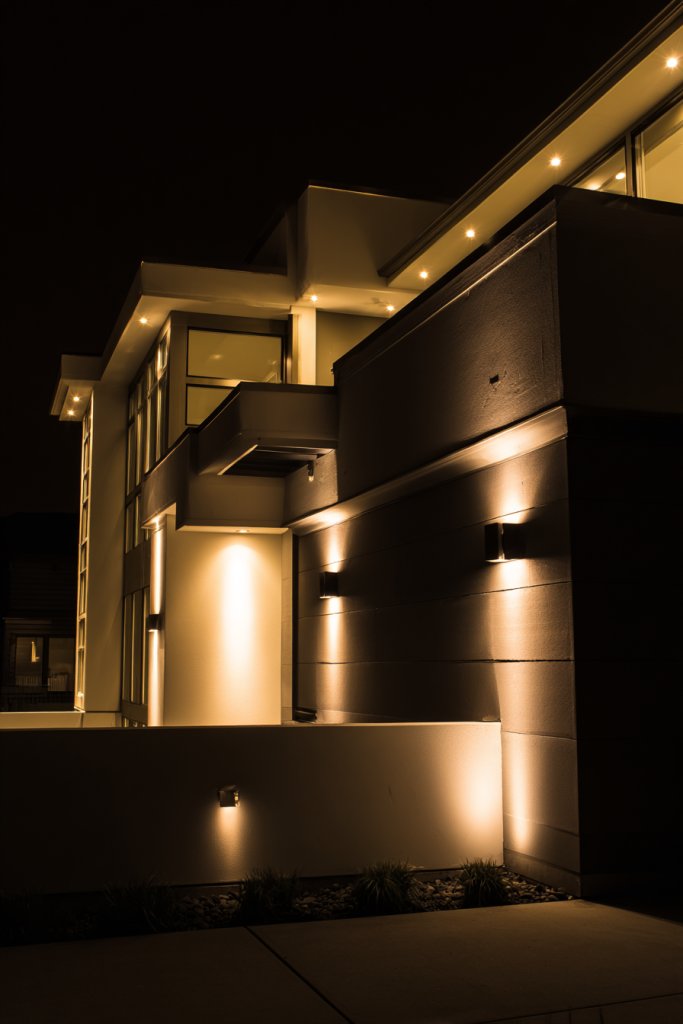
Want your home to look stunning even after dark? Layered exterior lighting creates depth, drama, and mood, transforming your façade into a nighttime masterpiece. But many fear that improper lighting can be harsh or unbalanced. The secret is combining different light sources for a harmonious, inviting glow.
Picture uplights accentuating textured walls or architectural features, downlights illuminating pathways, and wall washers highlighting façade details. The layering of warm and cool tones adds dimension, casting shadows and emphasizing shapes. Light interacts with textures and materials, creating a dynamic, multidimensional appearance. The overall effect is a welcoming, sophisticated exterior that beckons at night.
Mix different fixtures—LED spotlights, strip lighting, and lanterns—to suit your style. Use dimmers and timers for mood control and energy efficiency. Seasonal updates might include string lights or accent lighting around landscape features. Keep the design uncluttered, avoiding excessive fixtures that could distract from architectural details.
Plan a lighting scheme that emphasizes key features without overloading the space. Use high-quality, weatherproof fixtures designed for outdoor use. Position lights at varying heights and angles to create layers and avoid flatness. Conceal wiring within soffits or behind features for a clean look. Test lighting at different times of day to refine the balance and effect.
Customize with color-changing LEDs or programmable scenes for holidays or special occasions. Add subtle accents like illuminated signage or textured wall lighting. Use lighting to highlight plantings, sculptures, or unique architectural details. Keep fixtures aligned with your overall design theme for cohesion.
Layered lighting transforms your home into a visual experience and enhances safety. It showcases your attention to detail and elevates curb appeal. With thoughtful planning, your exterior becomes a luminous statement that impresses day and night, making every evening special.
19. Use of Bold, Large-Scale House Numbers and Signage

Want your house to stand out from the street? Large-scale, bold house numbers and signage make your address instantly recognizable and add a modern touch. But many fear oversized numbers will look out of place or cluttered. The key is choosing the right size, font, and placement for maximum impact.
Imagine sleek, oversized metal numerals mounted directly onto your façade, illuminated subtly at night. The numbers are clean, bold, and in a contemporary font that complements your home’s style. Positioned near the entrance or on a prominent wall, they become an artful element that balances functionality with design. The contrast between the numbers and the background makes your address easy to find.
Experiment with different materials—brushed metal, acrylic, or backlit signage—for varied textures and light effects. Play with color contrasts to ensure visibility and style harmony. Incorporate matching signage for your name or house motto to personalize the look. Adjust placement based on your house’s architecture, ensuring visibility from the street.
Choose durable, weatherproof materials suitable for outdoor exposure. Use high-quality adhesives or mounting hardware to ensure stability. Position the numbers at eye level or slightly above for visibility and aesthetic balance. Incorporate subtle lighting like LED backlights or spotlights to enhance nighttime visibility. Regularly clean and check for stability.
Personalize with different finishes—matte, brushed, or polished—to match your exterior palette. Add decorative elements like a custom frame or textured background. Use lighting to highlight the signage during evening hours, making it a key feature. Consider seasonal updates like temporary decals or themed accents.
Bold house numbers elevate your home’s curb appeal and ensure visitors find you easily. They combine practicality with style, making a memorable first impression. With the right choices, your signage becomes a signature element that reflects your personality and taste.
20. Incorporation of Water Features with Modern Design
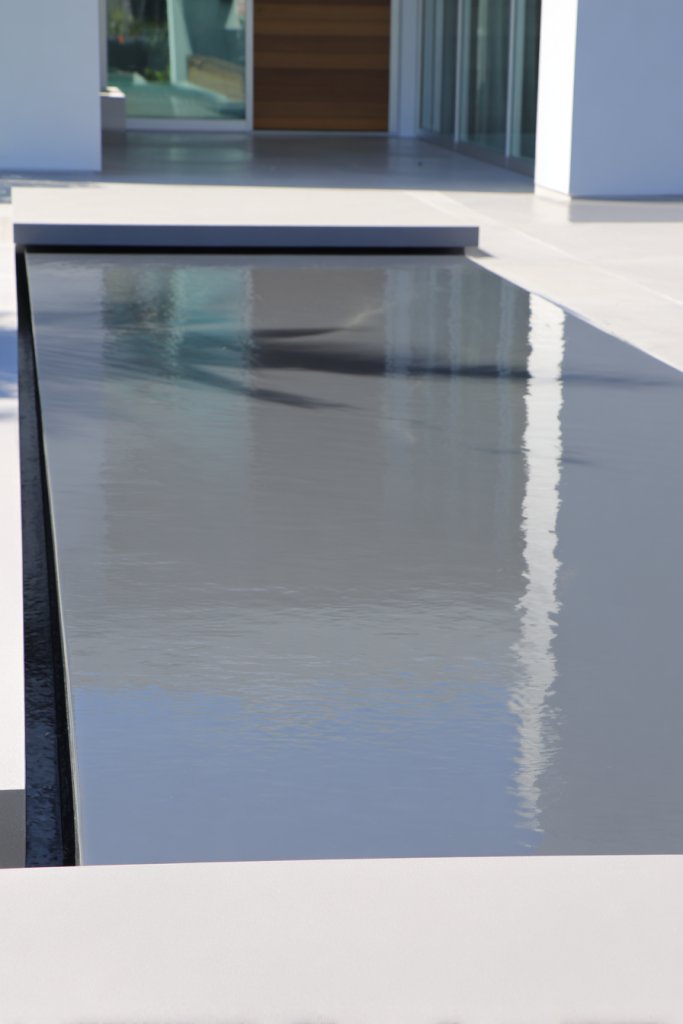
Craving a tranquil, luxurious vibe at your home’s entrance? Modern water features like sleek fountains and reflecting pools add serenity and upscale appeal. But many worry about maintenance or water waste. The secret is choosing minimalist designs and eco-friendly systems that make your exterior peaceful and stylish.
Imagine a simple, rectangular reflecting pool with smooth stone edges, perfectly framing the entrance. Adjacent, a sculptural fountain with flowing water in a geometric form creates a calming soundscape. The water’s surface reflects the sky and surrounding architecture, adding depth and tranquility. Soft lighting enhances the water’s shimmer at night, turning it into a focal point.
Select sleek, modern shapes—square, rectangular, or abstract—matching your overall design. Incorporate natural materials like stone, concrete, or metal for a contemporary look. Seasonal elements like floating candles or LED underwater lights can add ambiance. Small gardens or seating areas nearby turn the water feature into a relaxing retreat.
Work with specialists to design water features that suit your space and style. Use energy-efficient pumps and filtration systems to reduce water waste and maintenance. Install waterproof lighting to highlight water movement and create ambiance. Regular cleaning and checks ensure crystal-clear water and smooth operation. Consider eco-friendly options like recirculating systems.
Add personal touches like custom sculptures or engraved stones in the water feature. Use lighting to create moods—soft glows for serenity, brighter effects for events. Incorporate natural elements like pebbles or aquatic plants to enhance the design, avoiding restricted items. Surround the feature with modern outdoor furniture for a complete outdoor living space.
A water feature elevates your exterior into a calming oasis, blending art and nature. It adds value and a sense of tranquility, making every day feel like a retreat. With thoughtful design and maintenance, your home exudes luxury and serenity, impressing guests and enhancing your lifestyle.
21. Incorporation of Sustainable and Smart Elements
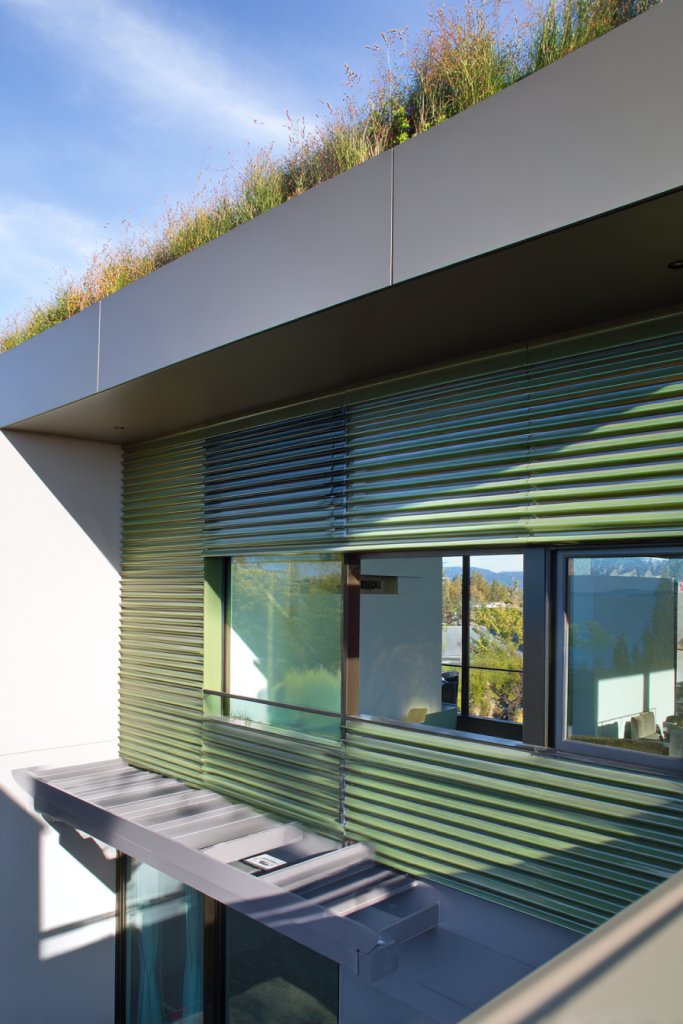
Dreaming of a home that’s both stylish and eco-conscious? Sustainable and smart exterior features are the future, combining technology with environmentally friendly design. But many worry these elements are complicated or expensive. The secret is integrating smart, energy-efficient solutions seamlessly into your exterior for a modern, responsible home.
Imagine solar-powered exterior lighting embedded into walls and pathways, controlled via smartphone apps. Smart sensors detect movement and adjust lighting or security cameras accordingly. Rainwater harvesting systems blend into the landscape, subtly collecting and filtering water. These features work together harmoniously, creating a tech-savvy yet eco-friendly ambiance that’s sleek and unobtrusive.
Choose discreet solar panels that blend into roofing materials or are integrated into architectural features. Use smart irrigation systems for your landscaping, conserving water effortlessly. Incorporate energy-efficient materials like insulated panels or reflective coatings. Seasonal adjustments include automated shading devices or outdoor power outlets for electric vehicles or tools.
Partner with specialists to select and install high-quality, weatherproof smart systems. Ensure compatibility with your home automation platform. Use durable, eco-friendly building materials that reduce your carbon footprint. Prioritize systems that are easy to upgrade or expand as technology advances. Regularly update software for security and efficiency.
Customize your smart home features with personalized settings—lighting moods, security alerts, or energy usage reports. Incorporate eco-friendly landscaping that requires minimal water or maintenance. Use sustainable materials with finishes that age gracefully and require less upkeep. Add signage or decals indicating your eco-conscious efforts for added impact.
Sustainable and smart elements showcase your commitment to innovation and responsibility. They reduce long-term costs and environmental impact while increasing your home’s appeal. With the right planning, your exterior becomes a showcase of modern ingenuity—beautiful, efficient, and future-ready.
Conclusion
The contemporary exterior ideas showcased here provide a wealth of options to refresh and personalize your home’s look. Whether you prefer clean lines, natural textures, or striking architectural details, these concepts can help you achieve a modern appeal that stands out. Don’t hesitate to experiment and bring your vision to life—your dream home exterior is just an idea away!

Post Comment